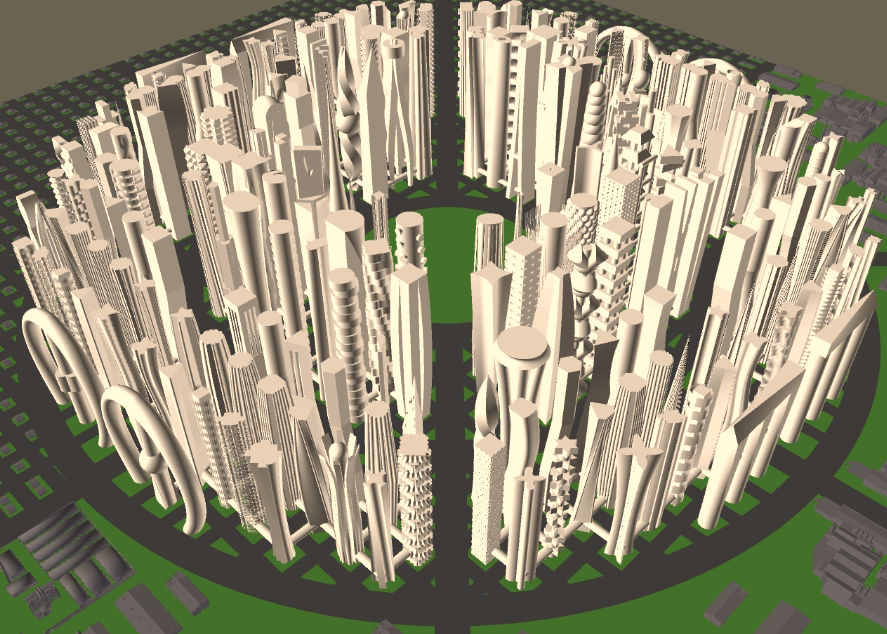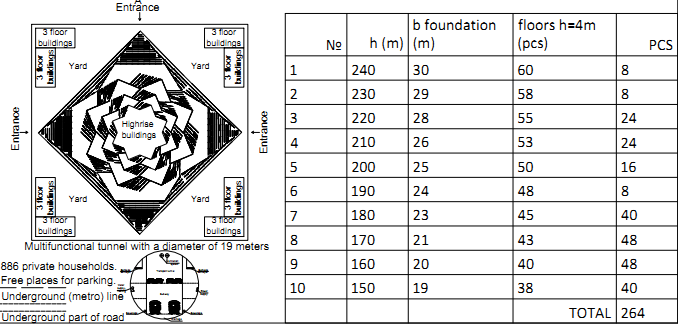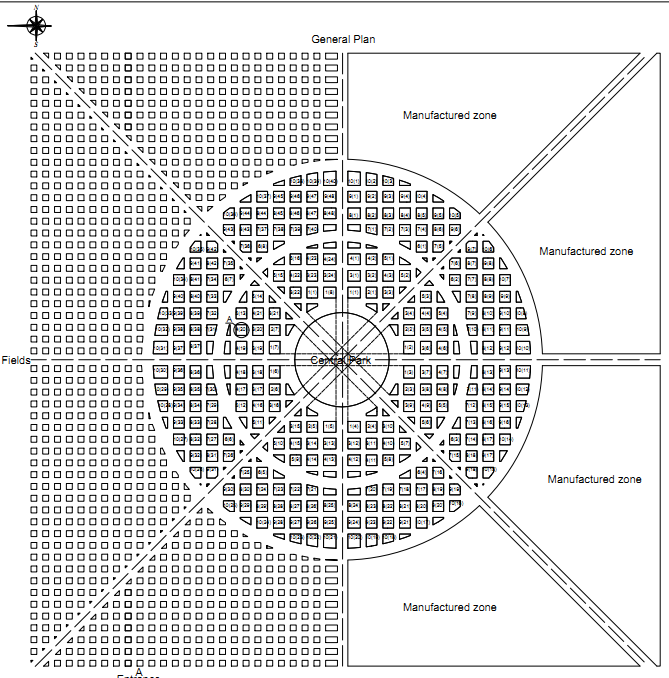Abstract
Modern cities often consist of detached buildings, such as cottages and apartment buildings. They are often connected by transport and utility networks. The disadvantage of such cities is high expenses for their infrastructure construction (highways, traffic intersections, metro network, utility lines, etc.). For major cities nowadays, these costs exceed 4 to 5 times the value of building the houses themselves. A large number of goods and people move daily for many tens of kilometres of underground and aboveground transport. An example would be the Moscow metro, which is over 650 km long. The problem of urbanization is directly related to the growth of population density in cities. This project presents a possible solution to this problem, using the example of the densely populated city of Tokyo. Note that the population of this city today is more than 13 million people. The new neighborhood project in the city takes into account the economic, environmental, social and geographic characteristics of Japan. The goal of this project is to create a compact urban environment with a high population density. This project allows to solve such problems as self-sufficiency of the city with goods and basic necessities, as well as the production and export of high-tech products in order to replenish the budget.
Keywords: Smart city, urbanization, architectural forms, skyscraper, ring road, industrial sector
Introduction
It is known that 3% of the earth's surface around the world is occupied by cities. At the same time, half of the world's population lives in cities. They use 75% of all resources and almost 70% of all electricity. It is also cities that emit 2/3 of greenhouse gases. According to preliminary estimates, by 2050 the world's urban population will reach 70% (Lele, 2017). This is especially true for many countries with a high population density: China, India, Japan. In India, scientists Patel (2015) and Kumar (Kumar, 2015) have dealt with the problems of urbanization. This problem has become especially urgent in connection with the increase in the number of megacities (Akbari, 2018; Bernardin, 2016; Langdon, 2017; Norton, 2008; Weiss-Tisman, 2015). Researchers propose to solve this problem by using the advantages of underground space in their research (Golubev, 2005; Kasyanov & Oksana, 2019; Zertsalov et al., 2015).
The term ‘The Smart city’ was first used in publications since the1990s, but it was promoted by IBM in 2010 through the Smarter Cities Challenge. After the time of global financial crisis, IBM focused its technology on urban infrastructure and regional authorities, sending experts to cities to come up with some solutions that could make the cities “smarter and more efficient” (Albino et al., 2015).
‘Smart cities’ have turned out to be in the focus of prioritized development met by city leaders to address the challenges of the rapid growth of urban areas. The ‘smart city system’ is monitoring urban infrastructure, ranging from road networks and ending with significant architectural structures. ‘Smart cities’ are aimed at using technology for service improvements and efficiencies while promoting investment and fostering economic development (Sosnovskikh & Shaidurova, 2016). As the population continues to grow and urbanization is increasing rapidly, smart approaches are needed to help build economically, socially and environmentally sustainable cities.
Problem Statement
The goal of this project is to create a compact urban environment with a high population density. This project allows to solve such problems as self-sufficiency of the city with goods and basic necessities, as well as the production and export of high-tech products in order to replenish the budget.
Research Questions
The project diagram is shown in Figure 1.
The concept of a smart city
According to the authors (Bernardin, 2016; Kumar, 2015; Patel, 2015; Weiss-Tisman, 2015), the strategy of a Smart city is based on several parameters.
Mobility. There should be used an easy, efficient, clean and convenient public transport in a smart city. The transport should be available as close as possible to citizens’ residence, which saves time and money. The transportation infrastructure has to operate at its best mobility and frequency to remove traffic jams and pollution. At that time, tourists should be provided with lifts to ensure user-friendly transportation.
Security. New technology companies and a huge Data Centre need employees to work at night to manage the city. These employers need to be well protected when they move to night work from home to the office. Therefore, safety assurance is a mandatory requirement and can be supported by using CCTV cameras and city traffic management system for intelligent crime prevention and monitoring security.
Environmentally friendly energy sources. Many big cities are quite heavily polluted. The pollution is mostly caused by industrialization and transport development. So it is necessary to use clean, environmentally friendly energy sources to reduce contamination. Vehicles and vehicles with an electric power operating on electricity and those with engines fuelled with natural gas, without gasoline should be used to minimize environmental risks through constant reduction of its emissions of hazardous substances. Many industries consume huge amounts of water and energy sources. It is also necessary to encourage using renewable and eco-friendly materials.
Water system. In the major cities of India, most of them still do not receive water in required amounts. This is because the water-supply system is laid just below the road, and it often results in accidents and breakdowns. Therefore, these water systems must be equipped with special sensors that detect leaks and can show them at a service location to minimize unwanted digging and material loss.
ICT (information and communication technologies) infrastructure. For the city to function effectively, it must be provided with conditions for fast communication between people. This can be enabled with a strong ICT network that allows people to enjoy spending time comfortably and fully benefiting from their time outdoors. The Internet and mobile communications should be accessible to people when they move, without much difficulty, and should be able to broadcast a sufficient amount of information for mass use.
Buildings. Buildings are residential units or working areas for a community. High-rise buildings are being built to increase population density. But, according to the survey, these high-rise buildings are considered to be carbon emissions. Therefore, buildings must be constructed using environmentally friendly materials with maximum natural daylight consumption and solar panels.
Control over natural disasters. Natural hazards are increasing because of the natural imbalance, and it is necessary to solve such problems properly. Appropriate forecasting methods and tools should be used to predict the impending disaster to minimize losses and wastes.
Independence. The lack of employment opportunities and lack of goods/services in the surrounding area make people migrate from one place to another. Cities must have a certain amount of independence and self-sufficiency so that they can meet the needs of these people in finding jobs, food, goods and services.
Social infrastructure. As the population grows, the demand for medical and educational institutions is also growing. As a result, the quality of the services provided is increasing, but they must meet the actual needs of today’s world. Every city should have high-class hospitals with a full range of health services, using advanced equipment for work. Educational institutions should be equipped with computers and projectors so that students could use visualization and multimedia in learning.
Management. The work of each department of city local self-government bodies is fragmented. Consequently, there is not enough effective coordination. It leads to delays in implementation, and additional costs might be required. Therefore, it is necessary to use ICT properly to communicate with various parts of the network and avoid delays in projects.
Diagram of the quarter projected

The authors position 264 buildings on this island
The high-rise part of the city is presented in the form of a dome of 264 high-rise energy-efficient buildings. This layout of buildings allows for effective insolation of buildings in densely built-up conditions, as well as break up strong wind currents. The proposed layout allows pedestrians, without going outside, to quickly move between buildings of various types in the high-rise part of the city using overhead covered walkways. The floors of buildings where these crossings are suitable can be used as a kind of closed street crossings, placing there commercial zones in the form of vending machines, as well as technical premises such as switchboards and heating points. The mesh-ring structure of highways allows, in densely built-up conditions, to pass large traffic flows during rush hour, without causing congestion on the road, which makes it possible to reduce the time for moving. High-rise buildings are divided into 10 groups in height from 150 to 240 meters. Each type of building has an individual architectural form and purpose. All buildings have underground and aboveground parking lots with the required number of parking spaces. Towers located closer to the central park are used for office purposes, while towers located closer to the outskirts of high-rise buildings are intended for the purpose of growing small agricultural crops. Industrial areas are located in such a way that the high-rise part of the city served as a noise barrier for the low-rise residential part of the city. Also, when building industrial zones, it is necessary to take into account the wind rose.
Purpose of the Study
The purpose of the study is to examine the concept of a Smart City based on the project proposed by the authors.
Research Methods
The following methods were used for the study.
- Implementation of a literature review on the use of Smart City technology.
- Creation of a smart city project in a modern software package.
Findings
Tokyo Residential Area Project
All buildings of the block have underground parking lots with individual sockets for recharging an electric vehicle. A system of multi-level high-speed elevators is provided for the transition between floors. Eco-friendly and economical LED roadside lighting has been installed with ergonomics in mind. The building size sheet and general plan of the city is shown in Figure 2 and 3.

One of the priority tasks that was solved during the implementation of this project is to ensure high mobility in densely populated buildings for this, certain engineering solutions were taken, such as:
1. Narrowing of the pedestrian part along the roads in the city center due to the movement of the flow of people into the urban skyway environment.
2. This is the implementation of work on cleaning the city at night in automatic mode, when the high-rise part of the city is free of cars due to the prohibition to leave them there at night.
3. This is the exclusion of garbage trucks from urban traffic and their replacement with underground conveyors that allow the garbage to be delivered directly to recycling.

4. Replacing bulky, non-environmentally friendly buses with small mobile electric buses.
5. Reducing the number of cars in road traffic by stimulating working citizens with cash bonuses when transferring to small mobile transport (bicycles, scooters, electric unicycle, gyro scooters), it is also possible to use this method of transportation in the skyway system.
6. Arrangement of helipads in both high-rise and low-rise parts of the city.
7. Preventing heavy trucks from entering the city center.
For the implementation of projects of this scale and the development of investments, the speed of project implementation is very important, which is achieved through the use of technologies of pre-fabricated structures. One of these technologies has been applied in the design of low-rise residential buildings. The construction of which needs to be done a lot and in a short time. For this, the technology of frame-panel construction will be applied, which allows you to build housing directly at the construction site, up to a finished product with a connection to utilities.
Conclusion
The implementation of such a project will allow one to gain experience in construction, a compact, but at the same time comfortable urban environment, capable of self-sufficiency at the same time with everything necessary. During the implementation of the project, the economy will be provided with an inflow of a large amount of investment, which will be invested in industrial, scientific and infrastructure projects. Manufacturers and suppliers of building materials will receive orders, and a large number of people will be provided with jobs. The result of the implementation of such a project will be not only a complete scientific cluster, but also a high economic effect from taxes and investments. Also, in the implementation of such a project, technologies in the field of security will be applied, which are relevant in our time, which will enhance the effect when creating not only a safe, but also a comfortable environment.
References
Akbari, M. (2018). Logistics outsourcing: a structured literature review. Benchmarking: An International Journal, 25(2), 1548-1580.
Albino, V., Berardi, U., & Dangelico, R. M. (2015). Smart Cities: Definitions, Dimensions, Performance, and Initiatives, Journal of Urban Technology, 22(1), 3-21.
Bernardin, K. (2016). Learning from the Piazza at Broad & Washington. https://hiddencityphila.org/2016/03/learning-from-the-piazza-at-broad-washington/ Date of circulation 23.12.2019
Golubev, G. E. (2005). Underground Urbanism and the City. IPTSMIKHiS.
Kasyanov, V., & Oksana, C. (2019). Use of Underground Space in Large Cities. IOP Conference Series: Materials Science and Engineering, 471(11), 112052. DOI:
Kumar, E. (2015). Urban Nexus and Linkages to GOI's New Schemes. 5th Regional Workshop on Integrated Resource Management in Asian Cities. The Urban Nexus, 21.
Langdon, P. (2017). Within walking distance: Creating liveable communities for all. New Haven. DOI:
Lele, M. D. (2017). Breakthroughs in Smart City Implementation Vishwa Niketan Institute of Management. Entrepreneurship, Engineering and Technology, 215-242.
Norton, P. (2008). Fighting Traffic: The Dawn of The Motor Age in The American City. MIT Press.
Patel, C. (2015). Smart cities: issues and challenges in Indian context. Proceedings of the National Conference on Sustainable Smart Cities (India, Surat), 1-6.
Sosnovskikh, L. V., & Shaidurova, E. V. (2016). From "smart home" to "smart city. Modern technologies in construction. Theory and practice, 2, 77-85.
Weiss-Tisman, H. (2015). Brattleboro: Struggling to Keep Downtown Viable. https://www.reformer.com/stories/brattleboro-group-hosts-forum-on-pedestrian-and-cyclist-safety,146057
Zertsalov, M. G., Konyukhov, D. S., & Merkin, V. E. (2015). The Use of Underground Space. ACB.
Copyright information

This work is licensed under a Creative Commons Attribution-NonCommercial-NoDerivatives 4.0 International License.
About this article
Publication Date
21 June 2021
Article Doi
eBook ISBN
978-1-80296-110-2
Publisher
European Publisher
Volume
111
Print ISBN (optional)
-
Edition Number
1st Edition
Pages
1-1168
Subjects
Social sciences, education and psychology, technology and education, economics and law, interdisciplinary sciences
Cite this article as:
Zemlyak, V. L., Vasilyev, A. S., & Boychin, R. E. (2021). Project For Solving The Problem Of Urbanization Of A Densely Populated City. In N. G. Bogachenko (Ed.), Amurcon 2020: International Scientific Conference, vol 111. European Proceedings of Social and Behavioural Sciences (pp. 1080-1086). European Publisher. https://doi.org/10.15405/epsbs.2021.06.03.143

